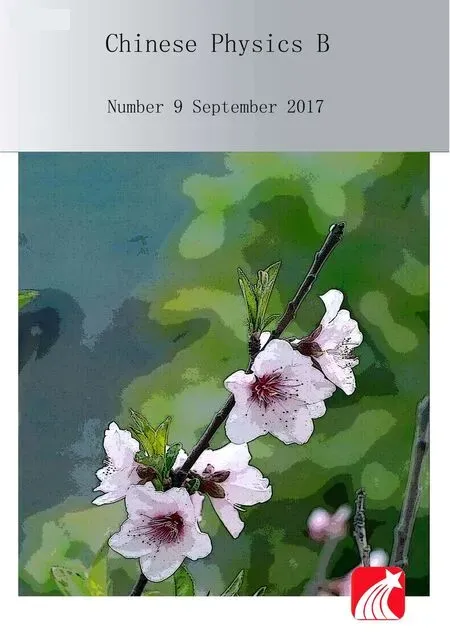Interaction between infinitely many dislocations and a semi-infinite crack in one-dimensional hexagonal quasicrystal∗
Guan-Ting Liu(刘官厅)and Li-Ying Yang(杨丽英)
1 College of Mathematics Science,Inner Mongolia Normal University,Hohhot 010022,China
2 College of Sciences,Inner Mongolia Agricultural University,Hohhot 010018,China
Interaction between infinitely many dislocations and a semi-infinite crack in one-dimensional hexagonal quasicrystal∗
Guan-Ting Liu(刘官厅)1,†and Li-Ying Yang(杨丽英)2
1 College of Mathematics Science,Inner Mongolia Normal University,Hohhot 010022,China
2 College of Sciences,Inner Mongolia Agricultural University,Hohhot 010018,China
By means of analytic function theory,the problems of interaction between infinitely many parallel dislocations and a semi-infinite crack in one-dimensional hexagonal quasicrystal are studied.The analytic solutions of stress fields of the interaction between infinitely many parallel dislocations and a semi-infinite crack in one-dimensional hexagonal quasicrystal are obtained.They indicate that the stress concentration occurs at the dislocation source and the tip of the crack,and the value of the stress increases with the number of the dislocations increasing.These results are the development of interaction among the finitely many defects of quasicrystals,which possesses an important reference value for studying the interaction problems of infinitely many defects in fracture mechanics of quasicrystal.
quasicrystals,infinitely many dislocations,semi-infinite crack,interaction
1.Introduction
Quasicrystal(QC)is a novel structure of solid discovered by Shechtman et al.in 1984,which is orientationally ordered, but noncrystallo-graphic.[1]Due to this discovery,Shechtman won the 2011 Nobel prize for chemistry.Since the quasicrys-tal was found,generalized elasticity theory of quasicrystals has been formulated,[2–8]and many analytical solutions for defect problems of QCs have been obtained.[9–15]As far as the problems of finitely many defects in QCs are concerned,there are some research papers about them.[16–24]But few results about the interaction among infinitely many defects in QCs have been reported.For QC,these problems become more complicated than conventional material due to the introduction of phason field.The purpose of this paper is to consider the interaction of more defects in one-dimensional(1D)hexagonal QCs by complex variable function method.First,the analytic solutions of elastic field of dislocation in the material are studied in the form of complex variable function;then the interaction force of parallel dislocations are given.Second, the analytic solutions of elastic field of a semi-infinite crack in the material are obtained by the Muskhelishvili method.Finally,the elastic fields of interaction between infinitely many parallel dislocations and a semi-infinite crack are given,which offer the basis of theory to discuss dislocation emission on the top of the crack,dislocation screen and crack shielding in 1D hexagon.Meanwhile,these theories are the development of the corresponding parts of classical elastic theory to QCs.
2.Basic equations
From Ref.[3],basic equations of the elasticity of QCs are given by

where σij,εij,and uidenote the phonon stress,phonon strain, and the displacement of phonon field respectively;Hij,ωij, and wirepresent the phason stress,phason strain,and the displacement of phason field respectively;Cijkl,Kijkl,and Rijklrefer to the independent elastic constants of phonon field,phason field,and the coupling phonon–phason field respectively, i,j=1,2,3.
For 1D hexagonal QC,taking its quasi-periodic axis as x3axis,using the symmetry of point group 6 mm,the generalized Hooke’s laws of the elasticity problem of 1D hexagonal QCs with point group 6 mm can be rewritten as follows:


where Cijdenotes the independent elastic constants of phonon field,Kirepresents the independent elastic constants of phason field,and Rirefers to the coupling elastic constants of phonon field and phason field.
When the straight dislocations are parallel to the quasiperiodic axis of 1D hexagonal QCs or the cracks penetrate along the quasi-periodic direction of 1D hexagonal QCs,the geometric properties of the materials will not change with quasi-periodic direction,then

Substituting Eq.(5)into Eqs.(2)–(4),the above problem turns into two independent problems as follows.
Problem I

This is an anti-plane elasticity problem of coupling phonon and phason fields.
Problem II

This is like plane elasticity problem of general crystal, which was studied in detail in Ref.[19].We omitted its solving here.
For problem I,substituting Eq.(9)into Eqs.(6)–(8),then substituting the obtained results into Eq.(10),the equilibrium equations in terms of displacements are obtained as follows:
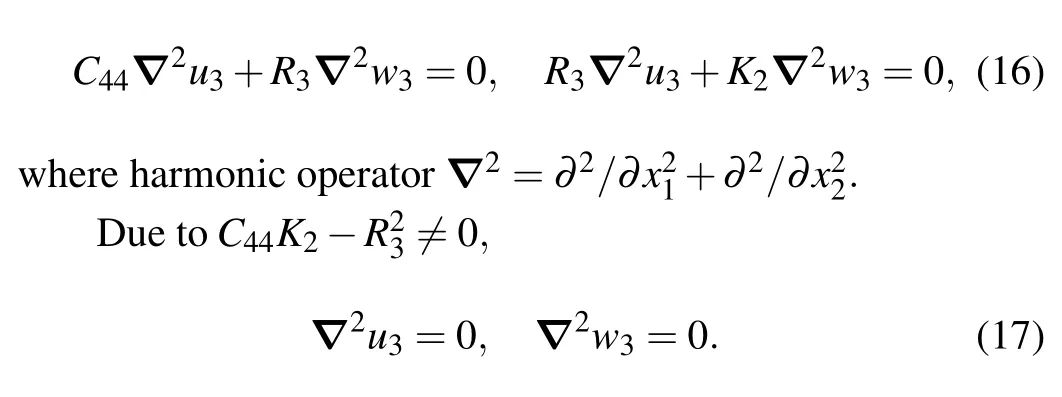
Equation(17)indicates that the terminal governing equations of problem I finally turn into two harmonic equations.
3.Solutions of the elastic field of infinitely many dislocations
The dislocation of QC is described by Burgers vector in higher-dimensional space.[9]The dislocation of 1D QC can be expressed by Burgers vector in four-dimensional space.Supposing that there is an infinitely long straight screw dislocation parallel to the quasi-periodic direction in an infinite 1D hexagonal QC body,by means of symmetry of the body,it is enough to investigate any plane perpendicular to the quasiperiodic direction of 1D hexagonal QCs body.Let the dislocation be located at ξ point in x1x2-plane and its Burgers vector be(b1,b2,b3,b⊥),then by means of superposition principle,(b1,b2,b3,b⊥)=(b1,b2,0,0)+(0,0,b3,b⊥).The (0,0,b3,b⊥)together with problem I constitutes a boundary problem of anti-plane elasticity of coupling phonon and phason field,whereas(b1,b2,0,0)together with problem II forms a boundary problem of plane elasticity.
Next,we will solve problem I only.Its dislocation condition is given by

where λ denotes the Burgers contour surrounding the dislocation ξ.Note that the two integrals both hold in physical space.
First complex representation of all field variables will be given.By means of properties of analytic function,from Eq.(17),we have

where η(z)and ζ(z)are two arbitrary analytic functions.Substituting Eq.(19)into Eqs.(6)–(8),through some derivation, then the complex representations of stresses are obtained as follows:
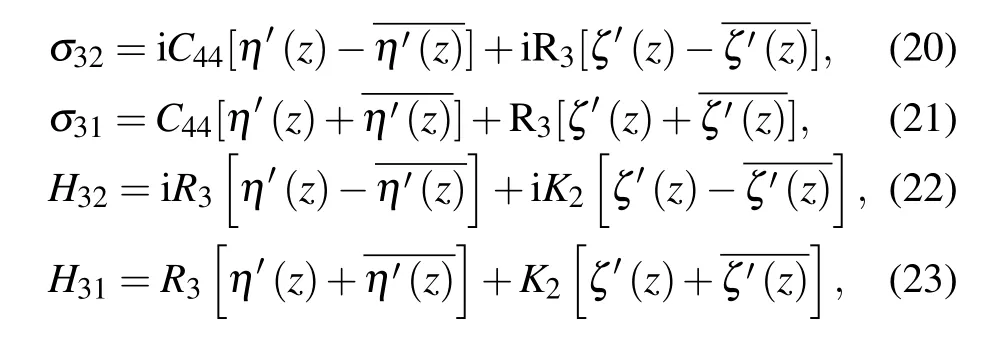
or

Substituting Eq.(19)into the dislocation conditions(18),integrating by means of Cauchy residue theorem in complex variable function theory,yields

From Eqs.(24)–(26),we have


where integral constants which denote rigid body motion are omitted.
From Eqs.(24)–(26),we have

Equations(27)and(28)give the analytic solutions of elasticfields of a dislocation in 1D hexagonal QC.
Supposing that there are infinitely many parallel screw dislocations located at points ξi(i=1,2,3,...),and their Burgers vectors areusing superposition principles,the action forces of the dislocations ξi(i=1,2,3,...),to arbitrary point z in x1x2-plane are

Hence,equation(29)gives the analytic solutions of the elastic field of infinitely many parallel screw dislocations in 1D hexagonal QC.However,unlike the case of finite many dislocations,equation(29)is two infinite series,so we need to study their convergence.According to a comparison test of series,we have the following theorem.
Theorem Suppose that there is a sequence of parallel screw dislocations located at points ξi(i=1,2,3,...)in z-plane of 1D hexagonal QC,and their Burgers vectors are(i=1,2,3,...).If the Burgers vectors are bounded and the seriesis absolutely converged,then the stresses(Eq.(29))resulting from the sequence of dislocations are finite for any zξn.
For example,let a sequence of parallel screw dislocations be located at points ξn=n2+i/n2in z-plane of 1D hexagonal QC,then their Burgers vectors will be bounded.Since the seriesis absolutely convergent,from the above theorem,we have the stresses
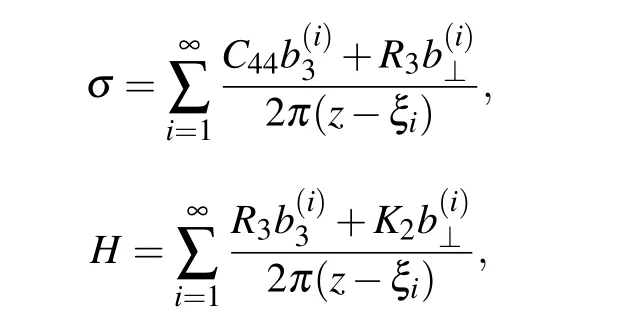
4.Solutions of a semi-infinite crack problem
In this section,the problem of a semi-infinite crack throughout the elastic body of 1D hexagonal QC along the quasi-periodic direction will be investigated.Due to symmetry,it is enough only to consider the periodic plane of the QCs. We postulate that a crack which is in complex plane x1+i x2(namely periodic plane)occupies the negative real axis,and the tip of the crack is taken to be the origin,thus building up a coordinate system,see Fig.1.The boundary conditions are given by

Equations(30)–(32)together with problem I constitute a coupling anti-plane boundary problem,which is Riemann–Hilbert boundary problem.According to Muskhelishvili’s method,[25]we have

Equations(33)and(34)give the stress fields corresponding to problem I.
5.Interaction between infinitely many parallel dislocations and a semi-infinite crack
We now study the interaction between infinitely many parallel dislocations and a semi-infinite crack in 1D hexagonal QC.The configuration that will be investigated is a semiinfinite crack through out elastic body of 1D hexagonal QC along the quasi-periodic direction and a sequence of infinitely long straight screw dislocations parallel to the quasi-periodic direction in it,see Fig.1.Like the last sections,it is enough only to consider the periodic plane.Let the crack on the complex plane x1+i x2(namely periodic plane)occupy the negative real axis,and the tip of the crack be taken as the origin, the sequence of infinitely long straight screw dislocations is located at points ξi(i=1,2,3,...),and suppose that Burgers vector of ξiis(see Fig.1,Interaction between semi-infinite crack and infinite dislocations).

Fig.1.Interaction between a semi-infinite crack and a sequence of dislocations.
Since the crack surface is free,the stresses generated by the dislocation ξiin the crack surface must be can celled by a distribution of stress sources on the crack surface at t.From Section 3,the distribution of sources are given by

Substituting Eqs.(35)and(36)into Eqs.(33)and(34)respectively,we have

Integrating by means of the substitution rule and integration of rational functions,the stress fields of the extra distribution of sources are obtained as
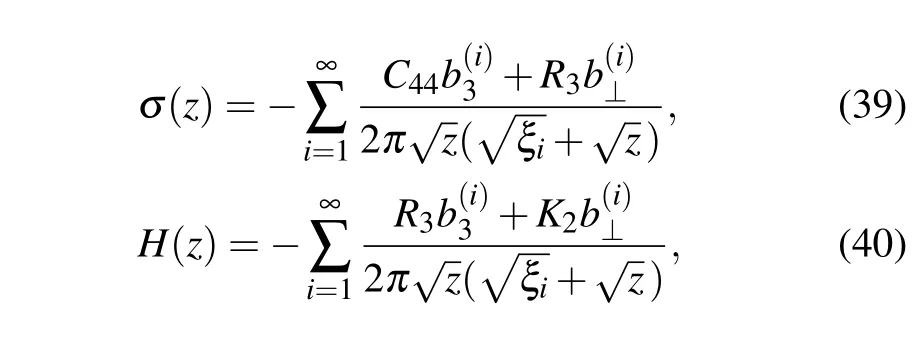
and then the stress fields of the extra distribution of sources in turn are added to the stress fields of the sequence of dislocations obtained in Section 3,resulting in stress fields of the interaction between infinitely many parallel screw dislocations and a semi-infinite crack,which are given by

From Ref.[26],we have C44=50 GPa,R3=1.20 GPa,and K2=0.30 GPa.Taking all Burgers vectors as 10−9m in magnitude,and letting ξ1=1,ξ2=2,ξ3=3,and ξ4=4,the stress fields of the interaction between a sequence of dislocations and a semi-infinite crack in 1D hexagonal QC are plotted in Figs.2 and 3,which show that the stress of phonon field and the stress of phason field vary with the position of point z,and the stress concentration occurs at the dislocation source and the tip of the crack.Figures 2 and 3 also illustrate that the stress of phason is very small compared with the phonon field. This is mainly because the magnitude of the elastic constant of the phonon field is about 100 times as large as that of phasonifeld.

Fig.2.Stress of phonon field varying with the position of point z.

Fig.3.Stress of phason field varying with the position of point z.
6.Conclusions and discussion
Finally,we summarize the overall conclusions and analyze the results obtained above.
(I)The interaction problems of infinitely many defects in one-dimensional hexagonal quasicrystals are studied first.The analytic solutions of stress fields of the interaction between infinitely many parallel dislocations and a semi-infinite crack in one-dimensional hexagonal QC are obtained,which offer the basis of theory to discuss arrays of discrete and continuously distributed dislocations in one-dimensional hexagon.
(II)Equations(41)and(42)indicate that the stress concentration occurs at the dislocation source and the tip of the crack.The interaction stress is bigger and bigger with increasing the component of Burgers vector,and smaller and smaller with increasing far from the distance of dislocations.
[1]Shechtman D,Blech I,Gratias D and Cahn J W 1984 Phys.Rev.Lett. 53 1951
[2]Ding D H,Yang W G,Hu C Z and Wang R H 1993 Phys.Rev.B 48 7003
[3]Wang R H,Yang W G,Hu C Z,et al.1997 J.Phys.:Condens.Matter 9 2411
[4]Liu G T,Fan T Y and Guo R P 2004 Int.J.Solid Struct.41 3949
[5]Fan T Y 2011 Mathematical Theory of Elasticity of Quasicrystals and its Applications.(Science Press:Beijing and Springer-Verlag:Berlin Heidelberg)
[6]Li L H and Liu G T 2012 Phys.Lett.A 376 987
[7]Gao Y,Xu S P and Zhao B S 2007 Pramana J.Phys.68 803
[8]Gao Y and Ricoeur 2011 A Proceedings of the Royal Society AMathematical,Physical and Engineering Sciences 467 2622
[9]Ding D H,Wang R H,Yang W G,Hu H Z and Qin Y L 1995 Phil. Mag.Lett.72 353
[10]Fan T Y,Li X F and Sun Y F 1999 Acta Phys.Sin.(Overseas Edn.)8 288(in Chinese)
[11]Li X F and Fan T Y 1999 Phys.Stat.B 212 19
[12]Edagawa K 2001 Mater.Sci.Eng.A 309–310 528
[13]Li L H 2013 Chin.Phys.B 22 016102
[14]Li L H 2013 Chin.Phys.B 22 116101
[15]Guo J H and Liu G T 2008 Appl.Math.Mech.29 485
[16]Liu G T,Guo R P and Fan T Y 2003 Chin.Phys.2 1149
[17]Guo J H,Yu J and Si R 2013 Appl.Math.Comp.219 7445
[18]Guo J H,Yu J and Xing Y M 2013 Mech.Res.Commun.52 40
[19]Guo J H and Lu Z X 2011 Appl.Math.Comp.217 9397
[20]Jiang L J and Liu G T 2017 Chin.Phys.B 26 044601
[21]Li L H 2010 Chin.Phys.B 19 046101
[22]Li L H and Liu G T 2012 Acta Phys.Sin.61 086103(in Chinese)
[23]Li L H and Liu G T 2013 Phil.Mag.Lett.93 142
[24]Liu X and Guo J H 2016 Theor.Appl.Fract.Mec.86 225
[25]Muskhelishvili N I 1953 Singular Integral Equations Noordhoff, Groningen.
[26]Li X Y,Li P D,Wu T H,Shi M X and Zhu Z W 2014 Phys.Lett.A 378 826
20 March 2017;revised manuscript
20 April 2017;published online 27 July 2017)
10.1088/1674-1056/26/9/094601
∗Project supported by the National Natural Science Foundation of China(Grant Nos.11462020,11262017,and 11262012)and the Key Project of Inner Mongolia Normal University,China(Grant No.2014ZD03).
†Corresponding author.E-mail:guantingliu@imnu.edu.cn
©2017 Chinese Physical Society and IOP Publishing Ltd http://iopscience.iop.org/cpb http://cpb.iphy.ac.cn
- Chinese Physics B的其它文章
- Improved control for distributed parameter systems with time-dependent spatial domains utilizing mobile sensor actuator networks∗
- Geometry and thermodynamics of smeared Reissner–Nordström black holes in d-dimensional AdS spacetime
- Stochastic responses of tumor immune system with periodic treatment∗
- Invariants-based shortcuts for fast generating Greenberger-Horne-Zeilinger state among three superconducting qubits∗
- Cancelable remote quantum fingerprint templates protection scheme∗
- A high-fidelity memory scheme for quantum data buses∗

